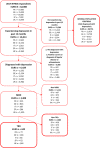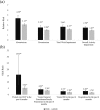The humanistic and economic burden of treatment-resistant depression in Europe: a cross-sectional study
- PMID: 31391065
- PMCID: PMC6686569
- DOI: 10.1186/s12888-019-2222-4
The humanistic and economic burden of treatment-resistant depression in Europe: a cross-sectional study
Abstract
Background: A patient is considered to suffer from treatment resistant depression (TRD) when consecutive treatment with two products of different pharmacological classes, used for a sufficient length of time at an adequate dose, fail to induce a clinically meaningful effect (inadequate response). The primary aim of the current study was to examine the humanistic and economic burden of TRD in five European countries, France, Germany, Italy, Spain and the United Kingdom, by comparing with non-treatment resistant depression (nTRD) and general population respondents.
Methods: The sample for this retrospective observational study was taken from the 2017 National Health and Wellness Survey conducted in five European countries. Demographic and patient characteristics were examined for TRD patients compared to respondents with nTRD and to the general population using chi-square tests or one-way analysis of variance for categorical or continuous variables, respectively. Generalized linear models were performed to examine group differences after adjusting these estimates for confounders.
Results: A total 52,060 survey respondents were examined, of which 2686 and 622 were considered to have non-treatment resistant and treatment-resistant depression, respectively. Relative to the general population, nTRD and TRD respondents reported significant decrements in health-related quality of life, including lower adjusted mental (- 12.1 vs. -18.1) and physical (- 2.5 vs. -5.4) component scores of the SF-12v2 and increased adjusted relative risk for work (2.2 vs. 2.7) and activity (1.9 vs. 2.5) impairment (all p < 0.001). Additionally, healthcare resource utilization was significantly higher for TRD patients more so than nTRD, compared to the general population, especially for healthcare professional visits (odds ratio nTRD = 5.4; TRD = 15.9, p < 0.001).
Conclusions: In conclusion, TRD patients had significantly lower quality of life, greater work productivity and activity impairment, and increased healthcare resource utilization as compared with nTRD and general population. The study findings suggest an unmet need exists among TRD patients in Europe.
Keywords: Activity impairment; Health-related quality of life; Healthcare resource use; Treatment -resistant depression; Work impairment.
Conflict of interest statement
TRD and BR are full-time employees of Janssen-Cilag. DHJ is employed by Kantar Health, which received fees from Janssen-Cilag for access to survey data, analysis, and reporting.
Figures


References
-
- Rush AJ, Trivedi MH, Wisniewski SR, Nierenberg AA, Stewart JW, Warden D, Niederehe G, Thase ME, Lavori PW, Lebowitz BD, et al. Acute and longer-term outcomes in depressed outpatients requiring one or several treatment steps: a STAR*D report. Am J Psychiatry. 2006;163:1905–1917. doi: 10.1176/ajp.2006.163.11.1905. - DOI - PubMed
-
- Nuckols CC. Diagnostic and statistical manual of mental disorders. American Psychiatric Association. 2013.
-
- Alonso J, Angermeyer MC, Bernert S, Bruffaerts R, Brugha TS, Bryson H, de Girolamo G, de Graaf R, Demyttenaere K, Gasquet I, et al. Prevalence of mental disorders in Europe: results from the European study of the epidemiology of mental disorders (ESEMeD) project. Acta Psychiatr Scand. 2004;109:21–27. doi: 10.1111/j.1600-0047.2004.00325.x. - DOI - PubMed
Publication types
MeSH terms
LinkOut - more resources
Full Text Sources
Other Literature Sources
Medical

